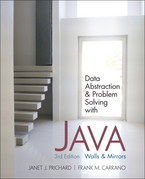



java.lang.Integer
Objects. Starting with an empty queue, use the add(E e) method to add
java.lang.Integer objects representing the numbers
(1 ≤ n ≤ 100,000) to the Queue.
java.lang.Integer
Objects that is fully populated with java.lang.Integer objects
representing the numbers (1 ≤ n ≤ 100,000) in the Queue. De-queue all
objects using the remove() method. Make sure to verify that the
java.lang.Integer objects are in the expected FIFO order.
java.lang.String
Objects. Starting with an empty queue, use the add(E e) method to add
java.lang.String objects representing the strings
("String 1" ≤ s ≤ "String 5,000") to the Queue.
Use the Iterator() method to obtain a java.util.Iterator
object. Use the java.util.Iterator object to display the strings
in the queue.
java.lang.String
Objects that is fully populated with java.lang.String objects
representing the strings ("String 1" ≤ s ≤ "String 5,000") in the Queue.
Use the Iterator() method to obtain a java.util.Iterator
object. Use the java.util.Iterator object to display and remove
the strings from the queue.
Please make sure that all your Java programs are in the default package.
Please compress the Java programs as a zip file containing:
Please submit your zip file at the
Mimir Platform Website
.